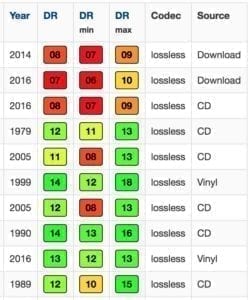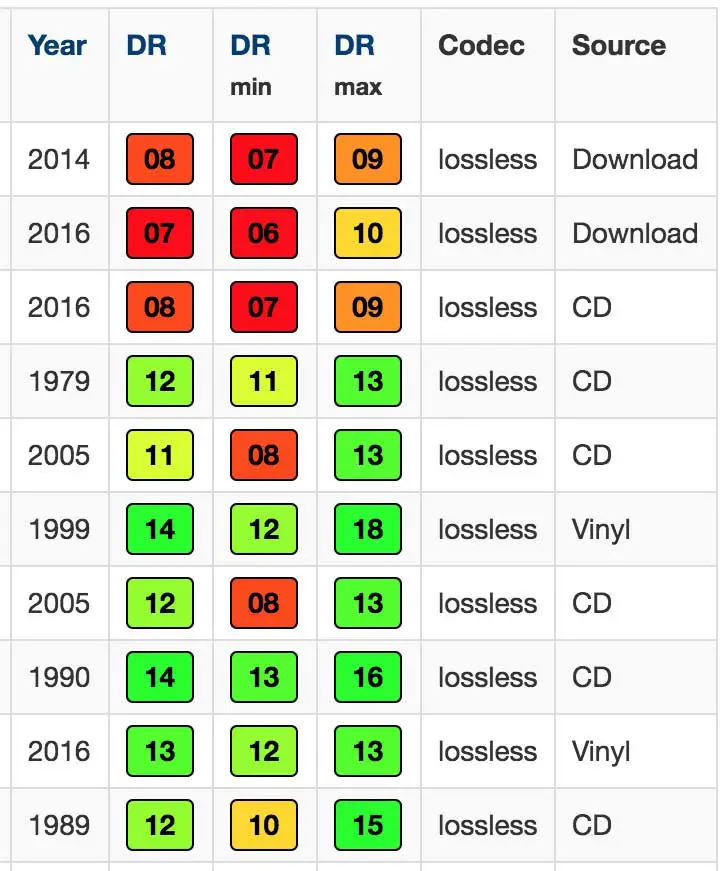As a young(ish) person discovering vinyl for the first time, I was fascinated by the claim floating around in many of the Internet’s forums that some vinyl releases have better dynamic range than their digital or CD counterparts. This immediately seemed odd to me, as digital music – on paper at least – is capable of much greater dynamic range. See figures below:
- 16 bit CD digital audio has a technical dynamic range of 96 dB, though many argue the perceived range is higher when taking dithering into account.
- Vinyl records typically yield 55-65 dB.
With the above in mind, I began exploring why some vinyl records have greater dynamic range – rightly concluding that mastering lay at the heart of the issue. And while most of what I discovered was correct (some vinyl releases are intentionally mastered with more dynamic range), it turns out some of the information is actually quite misleading.
It would seem, there probably isn’t anywhere near the amount of vinyl releases out there with better dynamic range than we’re led to believe.
The Dynamic Range Database
 In my first article exploring this topic, I referenced a website called the Dynamic Range Database (DRD), or dr.loudness-war.info.
In my first article exploring this topic, I referenced a website called the Dynamic Range Database (DRD), or dr.loudness-war.info.
The DRD is a crowd-sourced database that invites audio enthusiast to record the dynamic range of commercially released music and upload their results. Over time, the database has grown to include multiple releases of the same album on different formats, allowing users to compare the dynamic range. The idea is to promote the importance of dynamics and expose the loudness war.
Among the results, of course, are plenty of vinyl rips (both modern and old) where users have used the dynamic range metering software to measure and compare vinyl and digital releases of the same record. And why not!? Surely if the vinyl copy has greater dynamic range, the results will speak for themselves?
On first glance, the results appear to back the theory up; most vinyl record rips score higher dynamic range figures. However, all is not quite as seems…
The TT Dynamic Range Meter Doesn’t Work on Vinyl
It turns out, the dynamic range meter that folks are using to measure different releases doesn’t work accurately on vinyl records – or at least according to mastering engineer, Ian Shepherd. In the video below Ian uses a record he mastered to demonstrate the inaccurate readings produced by the popular TT meter. The example shown is strong evidence that you can’t use the dynamic range database to determine which format of a given album has better dynamic range, since this particular release utilizes the exact same master for digital and vinyl copies.
So how do I tell if the vinyl copy is more dynamic?
Truth be told, you have to use your ears. Alternatively, you can do some research online and see what other listeners are saying about the vinyl copy (the Steve Hoffman Music Forum is an excellent source for discussions on this topic). There are many vinyl releases with better dynamics, but ultimately, you have to listen with your ears and not your eyes.
But wait a minute, I thought you had to master vinyl separately?
This point is actually shrouded in myth and speculation. In fact, depending on which source you read, you’ll get a different answer to this question. But ultimately, a loudness war release can easily be pressed to vinyl, sadly.
According to Sound on Sound:
“The short answer to the question though is yes, sort of: separate masters are required for CD replication or digital distribution and vinyl records. However, in the majority of cases the mastering processing can be the same for both, as the crucial differences between them are practical (ie. the level and extent of limiting, the word length, and the sequencing of the files). A digital master for CD has to have a 16-bit word length, and it can be as loud and as limited as the client’s taste or insecurity dictates; with the vinyl master there is a physical limit to what can be fed to the cutting head of the lathe, and so heavily clipped masters are not welcome and can only be accommodated, if at all, by serious level reduction. For vinyl, the optimum source is 24-bit, dynamic, and limited either extremely lightly or not at all. The sequencing difference is that delivery from mastering for digital is either individual WAV files for download or a single DDPi file for CD replication, whereas for vinyl the delivery is generally two WAV files, one for each side of the record.”
…And returning to Ian Shepherd from Production Advice:
“There’s no technical reason that you can’t put “loudness war” style music on vinyl – except that it will sound even worse than the digital original.” He goes on to explain, far more eloquently than I can, why dynamic bass can cause the stylus to skip, but ironically, this can be solved by yet more compression – reducing the dynamic range. His post on “Why custom mastering for vinyl isn’t necessary” is well worth a read if you’d like to know more about his take on the topic.
Does this make vinyl irrelevant?
Well, no – not if you prefer it. A great sounding master can work beautifully on both vinyl and digital formats, but there are still many (myself included) who enjoy the sound imparted on a master by the analog format. It’s the subtle distortion that creates a sensation of warmth; it’s the ritual and process – the joy of music on a tactile physical format. There are notable examples where the vinyl copy has significantly improved dynamics – the 2012 vinyl release of Red Hot Chili Peppers Californication cut by Bernie Grundman is a great example – but ultimately, when it comes to which copy sounds better, you’ll just have to listen. For me, despite the difficulty in determining which version sounds better, vinyl is the only physical format I feel is worth owning – particularly when you consider the fact most new vinyl records come with a digital download. And, I still think vinyl will out live CD.




Korean group Blackpink released an album in 2021 in Dolby Atmos with high dynamic range (green colors). All their other digital releases are overloaded crackles due to clipping.
There is something else going on here. Even through this youtube video its easy to notice that CD song copy sounds noticeably louder than Vinyl version. Flattening the bands (brickwalling) on the wave charts is causing that, this is increasing so called ‘loudness’, where many different sounds are played simultaneously with very similar volume. We perceive it like a louder sound (our hearing works like this). This has an important implication, you can (and should, comparing to CD version) turn the volume a bit up, while listening to vinyl version. And then those non-brickwalled sound waves will have an effect of what is called, better ‘instrument separation’, ‘soundstage’ etc.
On your Master Level sub window in the left corner this is also visible. Vinyl version bounces there much wider across the scale then CD one. While CD one is mostly sticked to -6db which creates a wall of sounds that are hitting your ears with everythng what is in the song.
You took the words right out of my mouth, Pablo. I was delighted to read your comment and it’s comforting to know there are people out there who understand this component of side-by-side comparisons. Check out the work of MusicVinylDigital.net as well as a platform of digitized vinyl we’re building called Burntable. We’re creating a licensed streaming service of unedited, hi-res digitized vinyl for this very reason; to give people another alternative to what’s offered by (supposed) lossless streaming services. I’d love to chat with you more and please contact us through the site.
Album Adele – “25” in Hi-res version 192/24 is over-compressed than CD and MP3 mastering. This is a new, anti-piracy business model. Vinyl can’t be ripped “bit perfect”. RAW PCM recordings (mixes) may be selled many times in many corrupted formats.
Something that is seldom, if ever, discussed in comparisons is vinyl noise in the form of clicks, pops, and other surface noise. Try as we might, they were for me unavoidable. I find them intolerable. If distortion is any deviation from the original, this is a distortion not found in other music delivery systems. I personally made the tradeoff and went to CD ‘s and downloads for this reason. I do miss the warmth of vinyl and tube amplification.
You’re buying damaged vinyl, and the undamaged ones are likely in dire need of a cleaning. On a good cart, my albums are FREE from clicks, pops, and other surface noise. Cheers!
try the KLH analog noise reduction system – it’s magic in a black box
I’d recommend being careful with some of these noise reduction systems as they have a habit of shaving off critical transients.
[…] music is capable of much greater dynamic range (96dB for CD vs 55-65dB for vinyl). It’s difficult to measure the dynamics of vinyl accurately, but there are notable examples of major releases with better dynamics on vinyl if you […]
[…] the accuracy of the FDR Meter especially when a CD and vinyl release use the same master (read more here). As this release was remastered for vinyl it should be pretty accurate […]